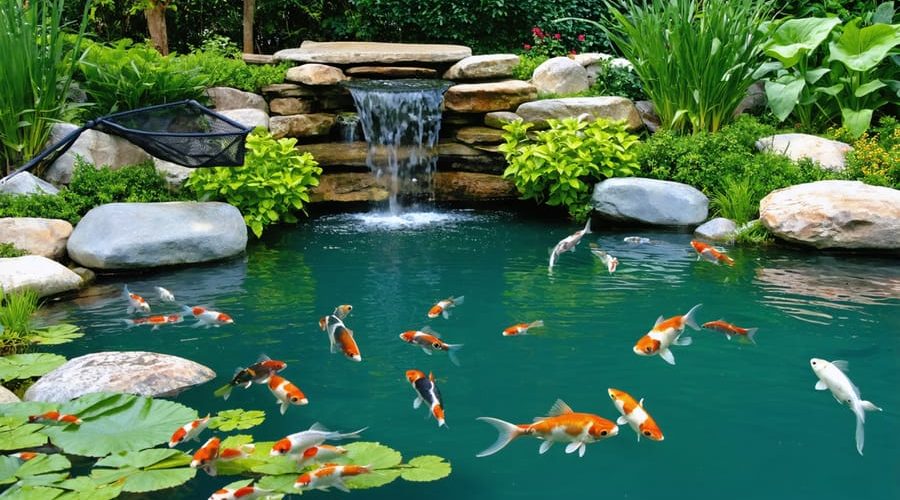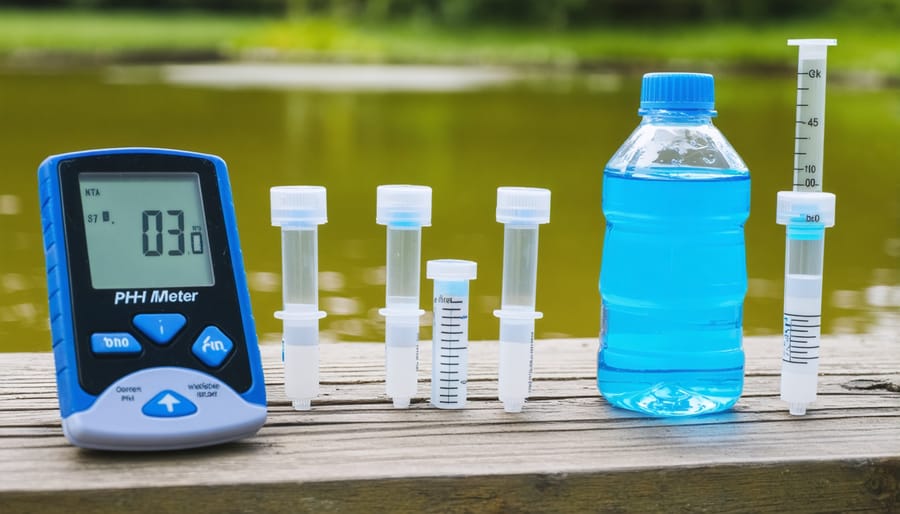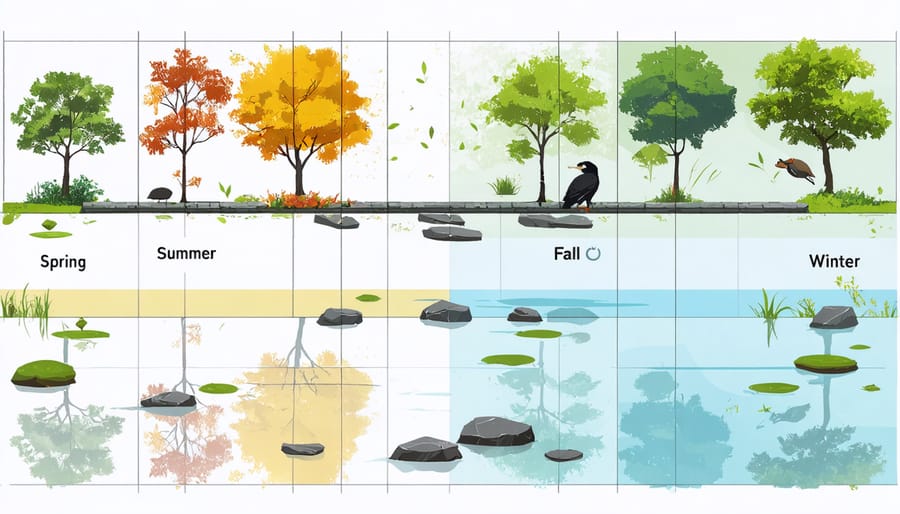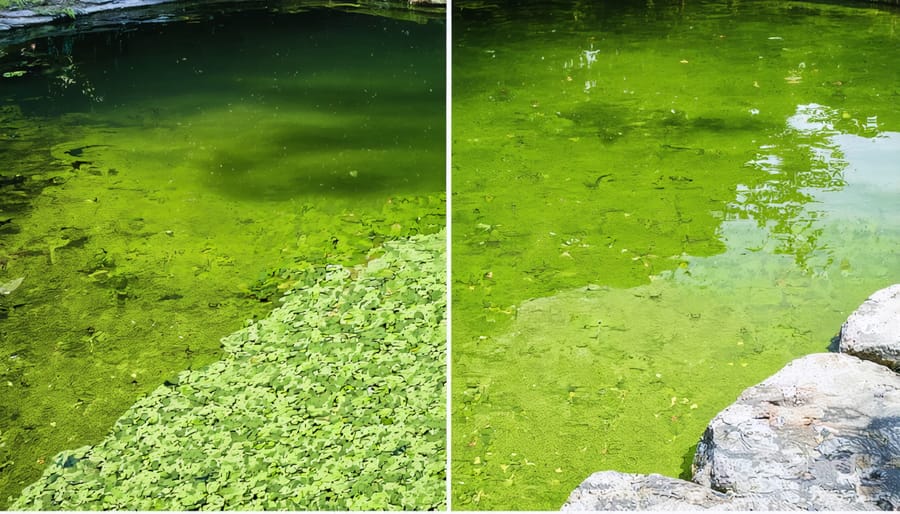
Simple Steps to Keep Your Yard Pond Crystal Clear All Season
Transform your backyard pond into a thriving ecosystem by mastering these essential pond maintenance tasks. Remove fallen leaves and debris weekly using a fine-mesh net to prevent water quality issues and protect your pump system. Test water parameters monthly, adjusting pH levels between 6.8-7.8 and maintaining proper ammonia levels below 0.25 ppm. Install an efficient filtration system matched to your pond’s volume, cleaning or replacing filter media every 2-3 months to ensure optimal water circulation. Balance your pond’s ecosystem by maintaining a ratio of one inch of fish per ten gallons of water and incorporating oxygenating plants that naturally combat algae growth. Regular maintenance not only preserves your pond’s beauty but also creates a sustainable habitat for fish and aquatic life, turning your backyard water feature into a vibrant, low-maintenance sanctuary.
Essential Weekly Pond Maintenance Tasks
Water Quality Testing
Regular water testing is essential for maintaining a healthy pond ecosystem. Start by testing your pond water weekly using a reliable test kit that measures pH, ammonia, nitrite, and nitrate levels. The ideal pH range for most pond fish is between 6.8 and 7.8, while ammonia and nitrite should always read zero.
To test your water, collect samples from about 18 inches below the surface, away from waterfalls or fountains. Follow the instructions on your test kit carefully, making sure to use clean testing tubes and fresh testing solutions. Compare the resulting colors to the provided chart immediately, as readings can change if left too long.
Keep a log of your test results to track changes over time. If you notice sudden shifts in water parameters, this could indicate developing problems that need attention. High ammonia levels, for instance, might mean your pond is overstocked or your filtration system needs maintenance.
During summer months or after heavy rains, test more frequently as these conditions can cause rapid water quality changes. If you’re unsure about your readings, local garden centers often offer free water testing services.

Debris Removal and Skimming
Regular debris removal is essential for maintaining a healthy and attractive pond. Use a long-handled net to skim floating leaves, twigs, and other organic matter from the surface at least twice a week. This prevents debris from sinking and decomposing, which can affect water quality and strain your filtration system.
For more thorough cleaning, consider investing in a pond skimmer or surface skimmer. These devices work continuously to catch debris before it sinks, similar to a pool skimmer. Position your skimmer where wind typically blows debris, usually on the downwind side of your pond.
During fall, you’ll need to increase skimming frequency as leaves drop. Installing a pond net above your water feature can significantly reduce maintenance by catching leaves before they reach the water. Remember to empty skimmer baskets regularly to maintain optimal performance and prevent overflow, especially during heavy leaf fall seasons.
Filter Maintenance
Regular filter maintenance is crucial for keeping your pond water crystal clear and healthy for your aquatic life. Start by choosing the right filtration system for your pond size, then follow these simple maintenance steps.
Check your filter media weekly for debris buildup and rinse it gently with pond water, not tap water, to preserve beneficial bacteria. For mechanical filters, remove and clean the foam or filter pads monthly, squeezing them in a bucket of pond water until the water runs clear.
If you notice reduced water flow, inspect the pump intake for blockages and clean as needed. Biological filter media should only be cleaned when absolutely necessary, as it houses essential beneficial bacteria. During spring and fall, perform a thorough cleaning of the entire filtration system, replacing any worn components.
Remember to always keep your filter running 24/7, only turning it off during cleaning. This maintains consistent water quality and keeps your pond ecosystem balanced.

Seasonal Pond Care Requirements
Spring Preparation
As winter fades away, it’s time to wake up your pond and prepare it for the vibrant spring season ahead. Start by removing any protective netting or covers you installed for winter protection. Next, carefully rake out dead leaves and debris that may have accumulated, being mindful not to disturb any hibernating creatures.
Check your pond’s water level and top it up if needed, using dechlorinated water to protect your fish and beneficial bacteria. Inspect your pump, filter, and other equipment for any damage or wear. Clean these components thoroughly before reinstalling them, and ensure everything is functioning correctly.
Test your water parameters, including pH, ammonia, and nitrite levels. Spring is also the perfect time to divide and repot any overgrown aquatic plants. If you removed your fish for winter, gradually reintroduce them once water temperatures consistently stay above 50°F (10°C).
Consider adding beneficial bacteria to jumpstart your pond’s ecosystem and help break down any organic matter that accumulated over winter. Trim back any dead plant material and check the pond liner for any damage that may have occurred during freeze-thaw cycles.
Summer Management
Summer’s heat can put extra stress on your pond’s ecosystem, making proper maintenance crucial during these warm months. Start by checking water levels daily, as evaporation increases significantly. Top up the pond when needed, but be sure to use dechlorinated water to protect your fish and plants.
Keep your pond aerated by ensuring all pumps and fountains are working efficiently. Good oxygen levels help prevent algae growth and keep fish healthy. Consider adding floating plants like water lilies – they provide shade, reducing water temperature and limiting algae growth.
Monitor water quality weekly during summer. Test for ammonia, nitrites, and pH levels, especially if you have fish. If readings are off, make adjustments gradually to avoid shocking your pond’s inhabitants.
Trim dead leaves and flowers from aquatic plants regularly to prevent decomposing matter from affecting water quality. Clean filters more frequently than usual, as biological activity increases with warmer temperatures. If you notice excessive algae, consider using beneficial bacteria treatments to help maintain balance.
Remember to feed fish sparingly during very hot weather, as uneaten food can quickly compromise water quality.
Fall Cleanup
As autumn approaches, falling leaves become a significant challenge for pond owners. Start by installing a pond net above your water feature before the leaves begin to drop. Position it slightly above the water surface, creating a gentle dome shape to prevent leaves from collecting in the middle. This simple step can save you hours of cleanup work later.
Remove any leaves and debris from your pond at least twice a week during fall. Even with a protective net, some debris will find its way into your pond. Use a long-handled net to skim the water surface regularly, and don’t forget to check around plants and in corners where debris tends to accumulate.
Clean your pond’s filters more frequently during this season, as decomposing leaves can quickly clog them. If you have trees nearby, consider trimming overhanging branches to reduce debris fall. Remember to remove dead or dying aquatic plant material as well – these can sink and contribute to bottom sludge if left unchecked.
Before winter sets in, perform one thorough cleaning to remove any accumulated organic matter from the bottom of your pond. This helps prevent water quality issues when spring arrives.
Winter Protection
As temperatures drop, winterizing your pond becomes crucial for protecting your aquatic ecosystem. Start by removing fallen leaves and debris before they sink and decompose. Install a pond net above the water surface to catch additional falling leaves throughout the season.
For ponds with fish, maintain a small hole in the ice surface to allow proper gas exchange. You can achieve this using a floating de-icer or pond heater. However, avoid breaking the ice by hitting it, as this can harm your fish.
If you have a pump, either move it to a deeper area of the pond where it won’t freeze or remove it entirely for winter storage. Tropical plants should be brought indoors, while hardy varieties can be moved to the pond’s deeper sections.
Consider adding a winter bacteria treatment to help break down organic matter and maintain water quality. If your pond is shallow (less than 2 feet deep), you might want to drain it partially and bring sensitive fish indoors until spring returns.
Plant and Fish Care
Aquatic Plant Maintenance
Regular maintenance of your aquatic plants keeps your pond looking beautiful and functioning properly. Start by removing any dead or yellowing leaves from your water lilies and other floating plants – this prevents debris from sinking and decomposing in the water. For marginal plants growing along the edges, trim back overgrown stems and divide them every 2-3 years to prevent overcrowding.
Most aquatic plants benefit from monthly fertilization during the growing season. Use specially formulated aquatic plant tablets, pushing them deep into the soil near the plant roots. Be careful not to overdose, as excess nutrients can lead to algae problems.
Keep invasive plants in check by containing them in pots or barriers. Some vigorous growers like cattails and water iris can quickly take over if left unchecked. When replanting or dividing, use a heavy clay-based aquatic soil mix and avoid regular garden soil which can cloud your water.
During spring cleanup, remove any plants that didn’t survive winter and replant as needed. In fall, trim back dying foliage to about 2 inches above the water line. If you live in a cold climate, move tropical varieties indoors and lower hardy plants to the deeper, warmer parts of your pond.
Remember that a good balance of plants helps maintain water quality and provides shelter for pond life. Aim to cover about 60% of your pond’s surface with a mix of submerged, floating, and marginal plants.
Fish Health Monitoring
Monitoring your fish’s health is crucial for maintaining a thriving pond ecosystem. Healthy fish should display vibrant colors, swim actively, and maintain a healthy appetite. Watch for fish that gather near the surface during feeding time and move gracefully through all levels of the pond.
Key signs of healthy fish include clear, bright eyes, intact fins without tears or damage, and scales that lie flat against their bodies. Their gills should be red or pink, not dark or discolored. Fish should maintain a consistent swimming pattern without erratic movements or listing to one side.
Common health issues to watch for include white spots (ich), cloudy eyes, torn fins, or fish rubbing against pond surfaces. If fish appear lethargic, lose appetite, or gasp at the surface outside of normal feeding times, these could indicate water quality problems or illness.
Regular observation is your best tool for early detection. Check your fish daily during feeding time, noting any changes in behavior or appearance. Keep in mind that spring and fall are particularly critical periods when fish are more susceptible to stress and disease due to temperature changes.
If you notice any concerning symptoms, test your water parameters immediately and consider consulting a pond specialist. Quick action can prevent minor issues from becoming serious problems that affect your entire fish population.
Troubleshooting Common Problems
Algae Control
Keeping algae under control is crucial for maintaining a healthy and attractive yard pond. While some algae is natural and beneficial, excessive growth can quickly become problematic. Fortunately, there are several natural algae control methods you can try before reaching for chemical solutions.
Start by ensuring your pond has adequate surface coverage from floating plants, which typically should cover about 60% of the water surface. These plants compete with algae for nutrients and provide essential shade. Adding submerged plants like hornwort or anacharis can also help maintain water quality.
For immediate action, you can manually remove string algae using a pond rake or brush. Installing a UV clarifier will help control single-celled algae that cause green water. If you need to use chemical treatments, choose products specifically designed for ponds and follow dosage instructions carefully to protect your fish and plants.
Prevention is key – maintain proper filtration, avoid overfeeding fish, and regularly remove debris. Adding beneficial bacteria helps break down organic matter that feeds algae. For stubborn problems, consider adding barley straw extracts or phosphate removers, which naturally inhibit algae growth without harming pond life.

Water Clarity Issues
Clear water is essential for a healthy and attractive pond, but cloudiness can occur for various reasons. If your pond water turns murky, first check your filtration system to ensure it’s working properly. A clogged or inefficient filter can quickly lead to cloudy water. Regular cleaning and maintenance of your filter media will help prevent this issue.
Green water typically indicates an algae bloom, which can be addressed by reducing sunlight exposure using floating plants or adding beneficial bacteria that compete with algae for nutrients. Brown or tea-colored water often results from decomposing leaves and organic matter, making it crucial to remove debris regularly and install a pond net during fall.
Testing your water parameters is vital when dealing with clarity issues. High ammonia or nitrate levels can contribute to cloudiness and should be addressed promptly. Consider using natural water clarifiers or UV sterilizers for persistent problems. Remember that new ponds may experience temporary cloudiness as they establish their biological balance.
If the water remains cloudy despite these measures, you might need to perform a partial water change. However, avoid changing too much water at once, as this can disrupt the pond’s ecological balance.
Maintaining your yard pond doesn’t have to be overwhelming when you break it down into regular tasks. Remember to check water quality weekly, remove debris as it appears, and keep your filtration system clean. Seasonal maintenance like trimming plants, adjusting feeding schedules, and preparing for weather changes will keep your pond thriving year-round. Stay proactive with equipment checks and address small issues before they become major problems. Your dedication to these simple maintenance routines will reward you with a beautiful, healthy pond that provides years of enjoyment. When in doubt, start with the basics and gradually build your maintenance expertise. With consistent care and attention, your backyard water feature will remain a peaceful oasis for both you and your aquatic wildlife to enjoy.
